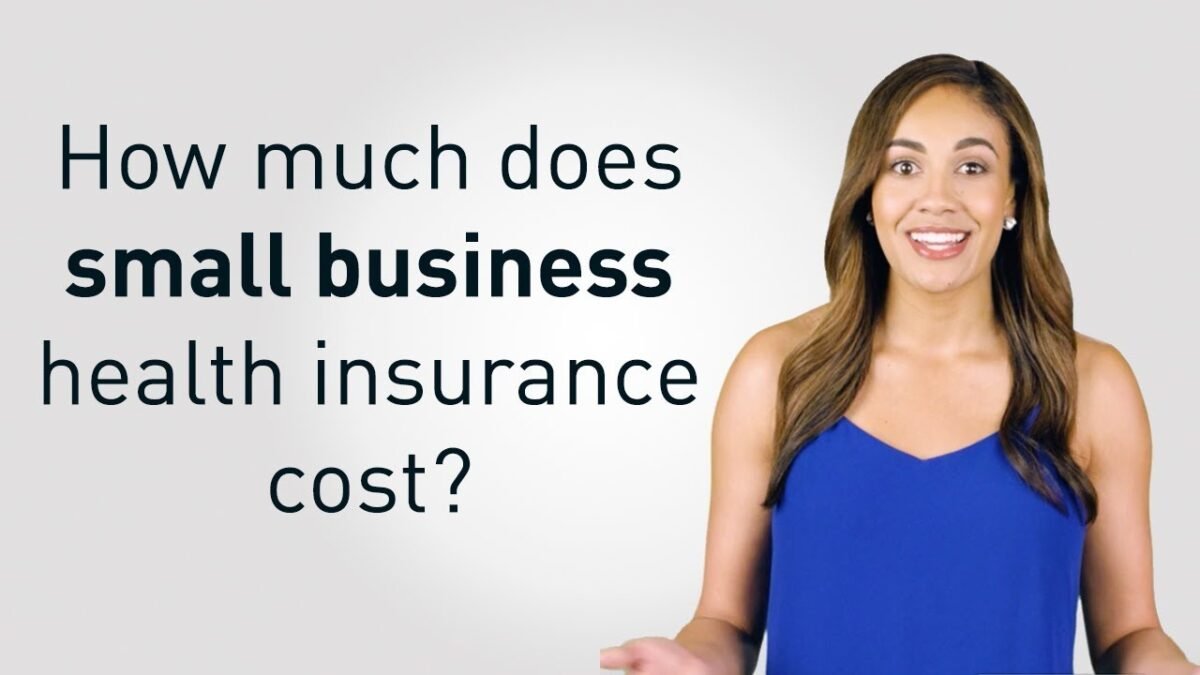
How Much Does Small Business Health Insurance Cost?
ow Much Does Small Business Health Insurance Cost: Laws don’t require small businesses with fewer than 50 employees to offer health insurance to their workers and families. But because American workers have come to expect health insurance as one of the benefits of full-time work, many small businesses feel pressured to offer it to attract the best job candidates and keep the best workers.
A survey of small business owners in the United States done in 2021 showed just how hard it can be for small businesses to deal with the rising cost of employer-provided health insurance.
- 55% of those who answered said that the most difficult challenge was the cost of giving health insurance to employees.
- Half of those polled gave health insurance to their employees, while the other half did not.
- 76% of those who didn’t give it said it was because of the cost.
- 53% of those who offered it had thought about stopping because costs were rising.
Based on these numbers, it is clear that insurance costs for small businesses can be too high for them to afford. But, how much does small business health insurance cost? Let’s dissect it.
How Much Does Small Business Health Insurance Cost?
The owners of businesses want to take care of their employees by giving them and their families health insurance. But owners who know that their bottom line makes all the difference in their company’s financial health must consider the cost. The actual price depends on things like the type of plan and insurer chosen (for example, PPOs usually have higher premiums than High Deductible major medical plans), the location, and the age range of plan participants.
According to a Kaiser Family Foundation (KFF) study from 2021, small businesses with 3 to 199 employees that offered health insurance to their workers paid about the same as large employers with 200 or more workers.
- A small business with single coverage pays an average of $651 per month.
- A small business worker with family coverage pays an average of $1,817 monthly.
Why does the average cost of health insurance for a small business tend to be less than that for an individual? This is partly because of the risk pool advantage, which says that the more people in a group, the more healthcare coverage costs are spread out. The Small Business Administration explains the benefit of group health insurance plans like this: the more people in the group, the more money the insurance company gets each month, which means they have more money if one of their members needs care.
What are the costs of a health insurance plan for a small group?
Like most individual plans, the cost of a small group health insurance plan is usually made up of several different payments, such as deductibles and premiums.
A premium is a regular monthly payment that policyholders must make to keep their health insurance. This payment is usually made once a month.
A deductible is an amount a policyholder must pay out of pocket before their insurance will start paying for medical costs.
To show how these ideas work, let’s say that your health insurance costs $400 a month and has a $1,000 deductible. That means that every month, you have to pay $400 to keep your insurance. It also means that if you have $2500 in medical bills in a year, you will have to pay the first $1,000 before the insurance company starts paying its share. After that, you’ll usually have to pay a copayment or coinsurance when you go to the doctor. Most of the time, you’ll only have to pay a small amount of the remaining $1500 in covered services. Look through eHealth’s affordable small business health insurance plans to compare different options and find the right coverage for you and your business.
The cost of health insurance for small businesses is affected by how much the employer and the employee pay.
As an employer trying to figure out how much a small business employee benefit will cost, you will need to know how much the company will pay toward the premium and how much the employee will pay. This is a way to split the costs.
There are significant differences across the country in how premium costs are split between the employer and the covered employee. According to the KFF 2021 Employer Health Benefits Survey, among small businesses (which the KFF study defines as having less than 200 employees), 29 percent of covered workers have an employer that pays the total premium for single coverage; only 3 percent of covered workers in small firms pay more than 50% of the premium for single coverage, and 10 percent of covered workers in small firms have an employer that pays the total dividend for family coverage.
As an example of the employer’s cost-share for employee benefits, a small business owner who paid between 25% and 50% of employees’ family coverage would pay an average of $463 to $926 per covered employee per month.
What is a copayment for small business health insurance?
A copayment is a set amount you may have to pay for medical supplies or services through your group health plan (also known as a copay).
Other healthcare services that usually require copayments are:
- There are many kinds of therapy.
- Office visits from experts
- ER or call an ambulance.
- Remember that employees, not their employers, pay for copayments.
Most HMO plans have copayments because they have contracts with healthcare providers that say they must. Other types of health insurance for small businesses, like PPO, POS, and EPO plans, may also have copayments as part of their costs.
Most of the time, the copay only applies to medical services that are covered by the plan. If you go to a provider not in your network, you may not be able to use your copayment, and you may have to pay the total amount or coinsurance percentage of the bill.
Out-of-Pocket Cost – What are the costs you pay for yourself?
Out-of-pocket costs are usually payments you make yourself for medical services. Your plan’s out-of-pocket maximum limits how much you and your health insurance company share in costs each year through your health plan. This is a fixed amount, like your deductible, but it is higher. Once you reach it, most health insurance companies will pay 100% of any covered health care costs for the rest of the year.
What are the maximum out-of-pocket costs?
An out-of-pocket maximum is an annual limit on how much you have to pay for your share of medical costs with your insurance company. The maximum out-of-pocket limit does not apply to your monthly premiums, balance-billed charges from healthcare providers outside your network, or services your plan does not cover.
How to figure out out-of-pocket maximums for health insurance plans for small businesses
Your out-of-pocket maximums may differ depending on the type of small business health insurance plan you choose. Usually, you can determine what they are based on how much you pay for employee premiums and how often your employees go to the doctor.
Small business health insurance plans with lower out-of-pocket maximums tend to have higher monthly premiums. In comparison, small business health insurance plans with higher out-of-pocket maximums tend to have lower monthly premiums.
Your employees’ healthcare needs are also a big part of figuring out their out-of-pocket maximums.
If your employees are generally healthy and don’t go to the doctor very often, they might choose plans with lower monthly premiums and a higher annual deductible. This is because they might need to meet the out-of-pocket maximums to get the insurance company to pay for their covered medical costs for the rest of the plan year.
On the other hand, employees who need doctor’s visits, treatments, and prescription drugs might choose plans with higher monthly premiums and a lower annual deductible. This would make it easier for them to meet out-of-pocket maximums and get full coverage from the insurance company for the rest of the plan year for all covered medical expenses.
What makes the price of health insurance for small businesses go up or down?
It’s essential to keep in mind that the prices listed above are averages. At least three things can change how much you end up paying for premiums:
- How old the people in your group are, and where are you
- Your choice when it comes to the costs you have to pay.
How to look for insurance?
The cost of your group plan may depend on how old the people who will be covered are and where you live.
Insurers set premiums based on the age and location of the group of employees, the plan’s features, and the level of coverage.
Under the Affordable Care Act, pre-existing medical conditions won’t usually affect your premiums, and no one can be denied coverage because of their health history.
What is the average cost of health insurance for a small group per worker?
Even though the overall cost of small-group health insurance is usually lower, the specific financial details of a plan depend on several things. So, when figuring out how much small business health insurance will cost for your company, consider the following:
- Employer contributions: In a small group health insurance plan, the cost of small business health insurance is usually split between the employer and the employees. According to the Society for Human Resource Management, the average worker has to pay $6814 a year in premiums for a plan that covers their whole family. The employer pays for the rest.
- Coverage in detail: Depending on what is covered, health insurance for a small business may go up. For example, in a dangerous industry, employers may buy small-group health insurance plans that cover certain illnesses and injuries caused by the risks. This can increase the total cost of health insurance for small businesses, whether it’s for the employer, the employees, or both.
- Tax credits: The Affordable Care Act allows for small group health insurance plans for employers with fewer than 25 employees, average wages of $52,000 or less, or who pay at least half of their employees’ premiums. These things can lower the cost of health insurance for small businesses.
How can small businesses cut down on the cost of health insurance?
There are many ways for small businesses to get health insurance for their workers. But not all of them cost the same. Some are more expensive than others. We’ve put together a few ways to save money that will help the quality of your health benefits for employees.
1. Plans that are self-funded and have level funding
Look for health insurance companies that offer self-funded plans with level funding.
On self-funded plans, employers only pay for their employees’ health care. This differs from fully funded projects, in which employers pay an insurance company a set amount to take on the financial risk of paying for any health care their employees might need. Insurers often charge a very high price for taking on this risk because they have to plan for the worst-case scenario.
So, self-funding is cheaper unless, all of a sudden, your employees need a lot of expensive health care that you didn’t plan for. Level funding comes into play here. With level funding, there is a limit on how much an employer has to pay for health claims in a given year. Stop-loss insurance pays for claims that go over that amount.
Self-funded plans with level funding eliminate the markups that come with fully funded projects and the risk of paying for too big claims.
2. Fair-value reimbursement (FVR)
Find insurance companies that use FVR.
FVR is an alternative to the way care has always been priced. The FVR model pays providers based on an established benchmark, such as Medicare reimbursement rates or the provider’s reported costs, so that healthcare providers can’t make up fees too high. This helps keep the costs of claims down and makes them easier to plan for over time.
FVR is hard to add to plans that are fully funded, so it is more common to find it in projects that are self-funded or level-funded.
3. Pharmacy benefit managers who are open to the public (transparent PBMs)
Look for insurers that work with PBMs that are easy to understand.
A pharmacy benefits manager (PBM) is a third-party service that helps connect health insurers with pharmacies and drug manufacturers. PBMs negotiate drug prices and handle distribution on behalf of insurers. This should make prescriptions cheaper and easier to get for people with health plans from those insurers.
In reality, the lack of regulation in the U.S. pharmaceutical industry makes it easy for PBMs to raise prices all along the supply chain for their benefit. That’s why it’s essential to ensure that your insurer’s PBM is transparent, which means they give the health insurance company all discounts and rebates. PBMs that are open about making money only charge the insurer a fixed administrative fee.
Where can you buy health insurance for a small group?
Small-group health insurance can be bought in the following ways for your employees:
- Right from a company in your state that sells insurance.
- They are using a broker for insurance. The broker will look for insurance policies that fit your business’s needs. They will charge a broker’s fee and a commission, usually a percentage of the premium. With Gusto and QuickBooks Payroll, for example, you can buy health insurance from brokers on their platforms.
- With the Small Business Health Options Program: SHOP is a way for businesses with fewer than 50 full-time equivalent employees to get insurance from the federal government (up to 100 in some states). Most states require that at least 70% of your employees are eligible to join your SHOP health plan. A small-business healthcare tax credit could cover up to 50% of the premiums for businesses with less than 25 employees.
- You are using an Employer Organization for Professionals. A PEO is a business you can hire to handle your benefits. PEOs can legally hire your employees along with you. PEOs have the same number of employees as larger companies because they are co-employers for several small businesses. This lets them get insurance rates that are better than most small businesses can get.
- Get on the QSEHRA list. This is a plan for small businesses that reimburse employees for certain healthcare costs. Employees can’t put money into their QSEHRAs through their paychecks, and the terms for employer contributions must be the same for each employee.
When you shop for a small-group health plan for your employees, the insurance company will give you quotes based on where your business is located and how many full-time equivalent employees you have.
Conclusion – How Much Does Small Business Health Insurance Cost?
This article is for general knowledge, and it may not be changed after it’s published. Don’t use this article as tax, accounting, or legal advice. Instead, talk to your tax, accounting, or legal expert.







